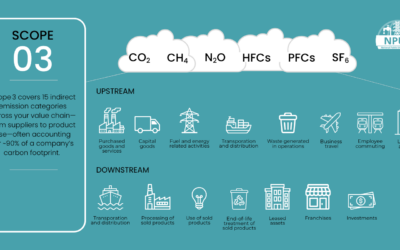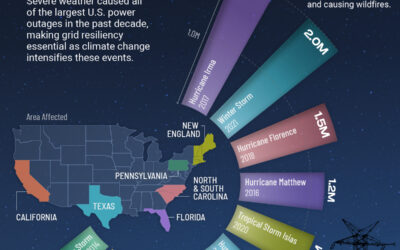Tracking U.S. Electrification, by Sector
Electrification refers to the process of replacing systems that run on fossil fuels with those powered by electricity.
Electrification can take different forms for each economic sector. For example, in transportation, replacing gas vehicles with EVs is a form of electrification. In homes and offices, it can involve switching from natural gas heating systems to electric alternatives like heat pumps.
Ultimately, the goal of electrification is to reduce greenhouse gas emissions, as electricity can be generated from renewable and low-carbon sources.
This infographic sponsored by the National Public Utilities Council tracks the current state of electrification in the United States, by sector, based on data from the Energy Information Administration (EIA).
The Most and Least Electrified Sectors
Before diving into the data, it’s important to understand the four energy-consuming sectors and what they comprise:
- Residential: Consists of homes, buildings, and living quarters that house private households.
- Commercial: Includes service-providing facilities and equipment of businesses, governments, and other private and public organizations.
- Industrial: Encompasses all facilities and equipment used for producing, processing, or assembling goods. This includes manufacturing, mining, agriculture, and construction.
- Transportation: Consists of all forms of transport including road, rail, marine, and air.
With that context in mind, the table below compares electrified and non-electrified energy usage across these sectors, in quadrillion British thermal units (quads). Electrified consumption refers to energy consumed in the form of electricity, whereas non-electrified includes energy sourced from fossil fuels, biomass, and other fuels.
The commercial sector leads in electrification with an almost-equal divide between electrified and non-electrified energy consumption. Following closely, the residential sector consumes about 45% of its energy in the form of electricity.
Meanwhile, the industrial and transportation sectors have the most potential for electrification. Overall in the United States, more than 80% of energy consumption is non-electrified.
To understand how these economic sectors are (or aren’t) using electricity, we dive deeper into their end-uses of energy below.
Residential and Commercial Sectors
In both the residential and commercial sectors, space heating is the largest use of energy. In fact, about 50% of all residential energy use is for space heating.
However, natural gas is the primary source of energy for space heating and adds to these sectors’ carbon footprint. Meanwhile, electricity is primarily used for space cooling, refrigeration, lighting, and computing equipment.
Alongside heat pumps for space heating, using electric water heaters, residential solar systems, and energy efficiency measures can help advance residential and commercial electrification.
Industrial Sector
The industrial sector accounts for one-third of U.S. energy consumption, with the majority of energy sourced from fossil fuels. The largest industrial energy consumers—the chemicals, mining, and refining industries—are heavily reliant on oil and gas.
In the bulk chemicals industry, oil and gas are the primary feedstocks for chemical production. Meanwhile, the refining industry uses large amounts of process heating and steam energy from the direct combustion of fossil fuels.
While electrifying industrial processes can be difficult, using technologies like electric arc furnaces, electric boilers, and integrating renewable energy can advance industrial electrification while reducing emissions.
Transportation Sector
The transportation sector has by far the most room for electrification, with 99.8% of its energy consumption being non-electric.
The obvious reason behind this are gasoline-powered vehicles, which are prevalent in all forms of transport. In fact, motor gasoline usage for light-duty vehicles alone accounts for 51% of energy consumption in this sector.
While the electrification of transportation is underway with electric vehicles (EVs), the share of electricity in the sector’s energy use (0.2%) highlights the room for growth through widespread EV adoption.
How Electrification Impacts Decarbonization
Electrification is a crucial building block for economy-wide decarbonization.
Replacing fossil-fuel powered systems with electric alternatives opens up the possibility of powering these systems with low-carbon electricity sources like renewables and nuclear power.
Ultimately, for all sectors, electrification serves as a tool to leverage advancements in clean electricity and renewable technologies. Therefore, combined with a decarbonized power sector, increasing the extent of electrification can enable deep reductions in greenhouse gas emissions.




